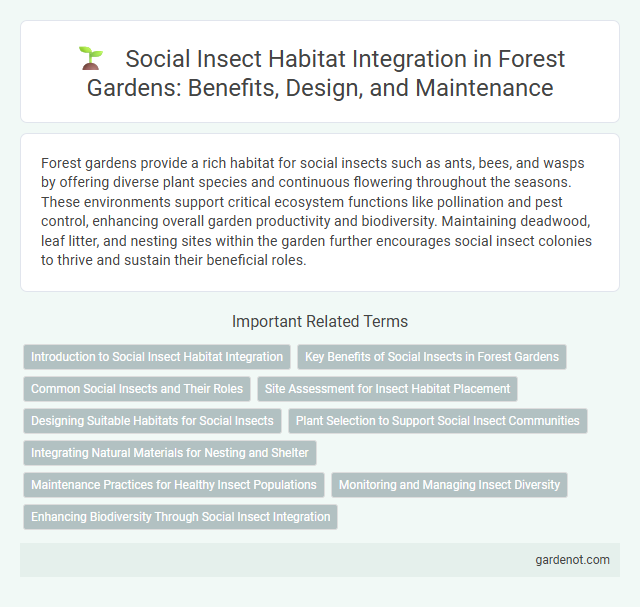Forest gardens provide a rich habitat for social insects such as ants, bees, and wasps by offering diverse plant species and continuous flowering throughout the seasons. These environments support critical ecosystem functions like pollination and pest control, enhancing overall garden productivity and biodiversity. Maintaining deadwood, leaf litter, and nesting sites within the garden further encourages social insect colonies to thrive and sustain their beneficial roles.
Introduction to Social Insect Habitat Integration
Social insect habitat integration in forest gardens enhances biodiversity by supporting species such as bees, ants, and termites that contribute to pollination, soil aeration, and organic matter decomposition. Designing habitats with nesting sites, foraging resources, and protective microclimates promotes colony establishment and ecological balance. Effective integration strengthens ecosystem services critical for sustainable forest garden productivity and resilience.
Key Benefits of Social Insects in Forest Gardens
Social insects such as bees, ants, and termites play a vital role in forest garden ecosystems by enhancing soil fertility through nutrient cycling and organic matter decomposition. Their pollination activities increase the productivity and biodiversity of fruiting plants, boosting overall garden resilience. Moreover, social insects contribute to natural pest control, reducing the need for chemical interventions and promoting sustainable forest garden management.
Common Social Insects and Their Roles
Common social insects such as bees, ants, and termites play crucial roles in forest garden ecosystems by enhancing soil fertility, pollinating plants, and managing pest populations. Bees contribute significantly to plant reproduction through effective pollination, while ants aid in nutrient cycling and seed dispersal, promoting biodiversity. Termites facilitate decomposition processes, breaking down organic matter and improving soil structure essential for plant growth.
Site Assessment for Insect Habitat Placement
Conducting a thorough site assessment is crucial for placing social insect habitats in a forest garden, focusing on factors such as sunlight exposure, moisture levels, and plant diversity that support colony health. Identifying natural nesting materials and shelter opportunities enhances habitat integration and promotes beneficial insect activity. Mapping microhabitats and monitoring seasonal changes ensures optimal positioning to maximize pollination and pest control benefits.
Designing Suitable Habitats for Social Insects
Designing suitable habitats for social insects in forest gardens involves creating layered vegetation structures that provide shelter, food sources, and nesting materials. Incorporating native plants with diverse flowering periods supports sustained nectar and pollen availability, critical for bees and wasps. Integrating deadwood, leaf litter, and soil patches enhances nesting opportunities for ants and termites, promoting natural pest control and soil health within the ecosystem.
Plant Selection to Support Social Insect Communities
Selecting native flowering plants such as goldenrod, clover, and milkweed enhances nectar availability crucial for social insects like bees and ants, promoting robust colony health. Incorporating diverse plant species that bloom sequentially throughout seasons ensures continuous food sources and nesting materials. Integrating woody shrubs and perennial herbs creates shelter and microhabitats to support the complex social structures of insect communities within forest gardens.
Integrating Natural Materials for Nesting and Shelter
Integrating natural materials such as dead wood, leaf litter, and hollow stems in a forest garden creates essential habitats for social insects like bees, ants, and wasps, fostering biodiversity and promoting natural pest control. These materials provide ideal nesting and shelter sites that support colony establishment and resilience against environmental stresses. Enhancing habitat complexity with organic debris also encourages pollination and soil health, vital for sustainable ecosystem functioning.
Maintenance Practices for Healthy Insect Populations
Effective maintenance practices for forest garden social insect habitats include regular monitoring to ensure suitable nesting materials and microclimate conditions are preserved. Minimizing pesticide use and promoting native plant diversity supports robust insect populations essential for pollination and pest control. Incorporating features such as dead wood, hollow stems, and soil patches provides critical shelter and breeding sites for ants, bees, and termites.
Monitoring and Managing Insect Diversity
Monitoring insect diversity in forest gardens involves regular surveys of species like ants, bees, and termites to assess ecosystem health and biodiversity levels. Employing methods such as pitfall traps and visual counts helps identify beneficial social insects that promote soil aeration and pollination while controlling pests. Managing these habitats through habitat enrichment and minimizing pesticide use supports the thriving populations of essential social insects, ensuring sustainable forest garden productivity.
Enhancing Biodiversity Through Social Insect Integration
Integrating social insect habitats such as ant nests, bee hives, and termite mounds within forest gardens significantly enhances local biodiversity by promoting pollination, natural pest control, and nutrient cycling. These insects contribute to healthier soil structure and increased plant diversity, creating a more resilient ecosystem. Encouraging diverse social insect populations supports forest garden sustainability and ecosystem balance.
Social insect habitat Infographic

 gardenot.com
gardenot.com